South Pole Halos - OPOD
South Pole Halos - A Spectacular Atmospheric Phenomenon
At the South Pole, a mesmerizing display of halos can be witnessed during certain atmospheric conditions. These halos are formed by the interaction of sunlight with ice crystals suspended in the air. Joseph Phillips captured a series of stunning images on January 2nd, 2014, when the near midsummer sun encircled the sky at a constant 23° high. Let's delve into the captivating world of South Pole halos and explore the science behind this enchanting atmospheric optics phenomenon.
The Atmospheric Research Observatory and its Role
The backdrop for these incredible halo displays is the Atmospheric Research Observatory at the South Pole. This facility serves a dual purpose: it collects long-term climate data while also focusing on ozone research. Situated in a clean air sector, the observatory provides an ideal location for studying atmospheric phenomena like halos. By analyzing these optical phenomena, scientists gain valuable insights into the composition and behavior of the Earth's atmosphere.
The Formation of Halos
Halos at the South Pole are created by the interaction of sunlight with ice crystals in the atmosphere. These crystals take on various forms, including randomly oriented hexagonal prisms and horizontal column crystals. The randomly oriented hexagonal prism forms contribute to the formation of the bright 22° halo and its fainter 46° counterpart. The rarity of the 46° halo can be attributed to the presence of indentations and defects on the hexagonal end (basal) faces of the crystals, which block the rays passing through.
Horizontal column crystals play a significant role in forming distinct features such as the upper tangent arc, supralateral arc, and infralateral arc. The sharpness of these arcs can vary depending on factors such as crystal tilt and structural flaws. Crystals with bubble inclusions or other imperfections can cause fuzziness in the arcs, resulting in a softer appearance. These natural crystal formations create a mesmerizing spectacle in the sky, captivating observers at the South Pole.
The Parry Arc - A Rare Sight
One of the most intriguing phenomena observed during these halo displays is the Parry arc. Surprisingly, even a small percentage of crystals (around 3%) is sufficient to generate this remarkable arc. The Parry arc is a result of the unique alignment and interaction of ice crystals in the atmosphere. While it is now more commonly seen on ski slopes where snow blowers generate perfect crystals, witnessing fully natural Parry arcs remains a privilege reserved for the pristine wilderness of Antarctica.
The South Pole Markers - Geographic and Ceremonial
Within this icy expanse, two distinctive poles can be found - the geographic pole and the ceremonial pole. The geographic pole, located on the left side of the image, marks the actual bottom of the world. Due to the movement of the ice sheet and slight shifts in Earth's crust, this pole is surveyed annually to ensure its accurate positioning. Each winter crew contributes to redesigning the marker, with the unveiling ceremony taking place on January 1st. This tradition allows each crew to leave their mark on this remote and significant location.
The ceremonial pole, resembling a striped barber shop pole with an orb on top, serves as an arbitrary marker for photographs and public relations. It is surrounded by flags representing the original signers of the Antarctic Treaty. While it may not have the same geographical significance as the true South Pole, it holds cultural and symbolic importance, adding a touch of human connection to this remote and desolate landscape.
A Glimpse into the Polar Plateau Wastes
As we gaze upon the South Pole halos, we are also treated to a panoramic view of the polar plateau wastes. The vast expanse of this icy wilderness creates a surreal backdrop for the atmospheric phenomena unfolding in the sky. The infralateral arcs, appearing near the horizon, add an ethereal touch to the scene. These arcs, formed by the interaction of sunlight with ice crystals, contribute to the overall grandeur of the South Pole halo displays.
In conclusion, the South Pole halos offer a captivating spectacle that combines natural beauty with scientific inquiry. As sunlight interacts with ice crystals suspended in the atmosphere, a stunning array of halos, arcs, and other optical phenomena grace the polar skies. These displays provide valuable insights into the composition and behavior of our atmosphere while offering a glimpse into the remote and majestic world of Antarctica. Whether it be the rare Parry arc or the shimmering 22° halo, the South Pole halos never fail to inspire awe and wonder in those fortunate enough to witness them.
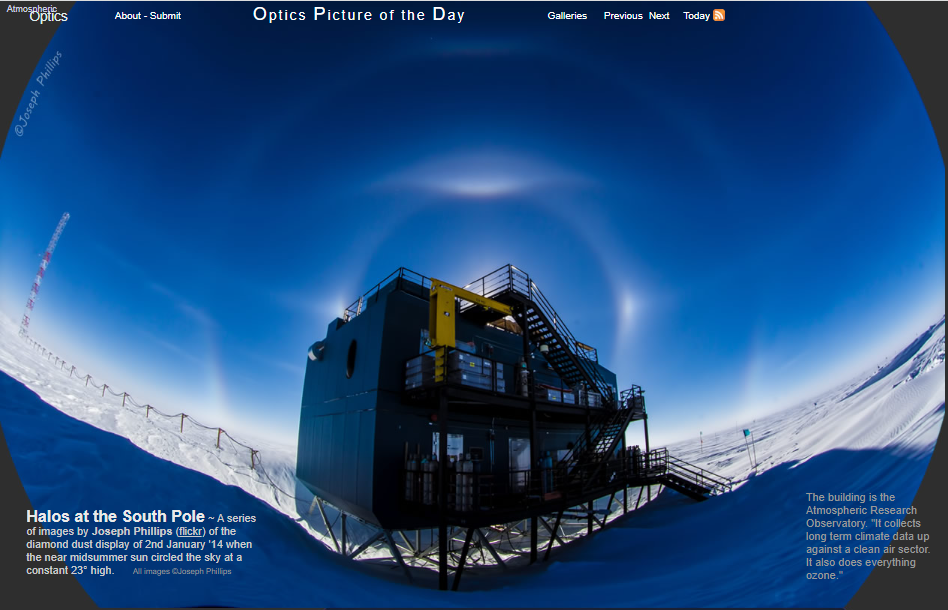
Halos at the South Pole ~ A series of images by Joseph Phillips (flickr) of the diamond dust display of 2nd January '14 when the near midsummer sun circled the sky at a constant 23° high. All images ©Joseph Phillips
The building is the Atmospheric Research Observatory. "It collects long term climate data up against a clean air sector. It also does everything ozone."
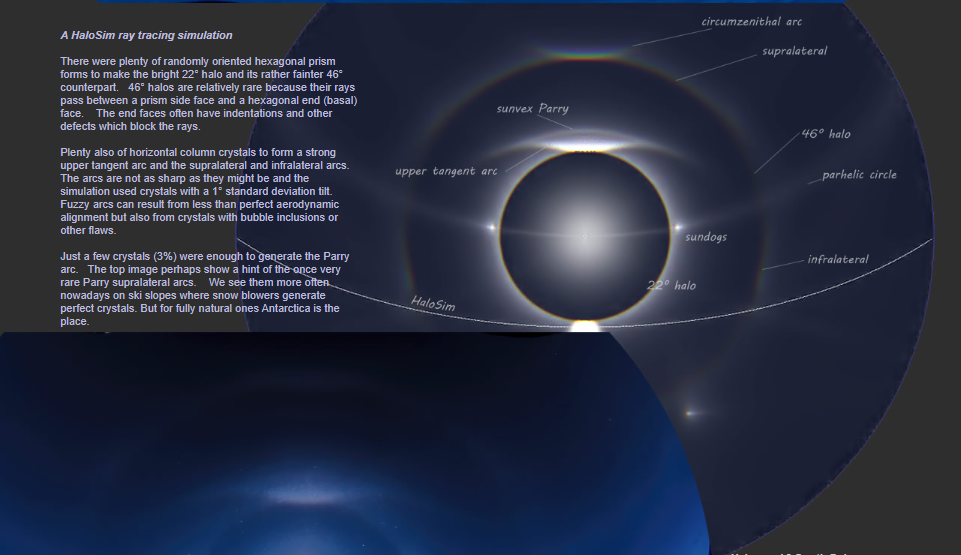
A HaloSim ray tracing simulation
There were plenty of randomly oriented hexagonal prism forms to make the bright 22° halo and its rather fainter 46° counterpart. 46° halos are relatively rare because their rays pass between a prism side face and a hexagonal end (basal) face. The end faces often have indentations and other defects which block the rays.
Plenty also of horizontal column crystals to form a strong upper tangent arc and the supralateral and infralateral arcs. The arcs are not as sharp as they might be and the simulation used crystals with a 1° standard deviation tilt. Fuzzy arcs can result from less than perfect aerodynamic alignment but also from crystals with bubble inclusions or other flaws.
Just a few crystals (3%) were enough to generate the Parry arc. The top image perhaps show a hint of the once very rare Parry supralateral arcs. We see them more often nowadays on ski slopes where snow blowers generate perfect crystals. But for fully natural ones Antarctica is the place.
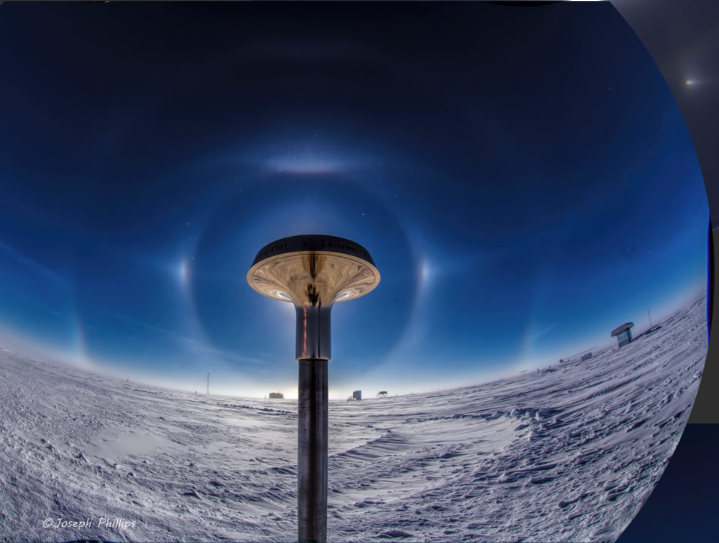
Halos and 2 South Poles
"Down here are 2 pole markers. The geographic pole (at left) is the actual bottom of the world. It's surveyed every year because the ice sheet we sit on moves .the poles also drift slightly relative to Earth's crust.. It moved about 15 feet from last year. This marker is redesigned every year by the previous winter crew (i.e. since I'm wintering this season, I'll be part of the design for the 2015 pole marker) and unveiled during a ceremony on Jan 1.
The striped barber shop looking pole with the orb on top (below) is the ceremonial pole and is surrounded by flags of the original signers of the Antarctic Treaty. Its an arbitrary marker that's great for pictures and public relations."
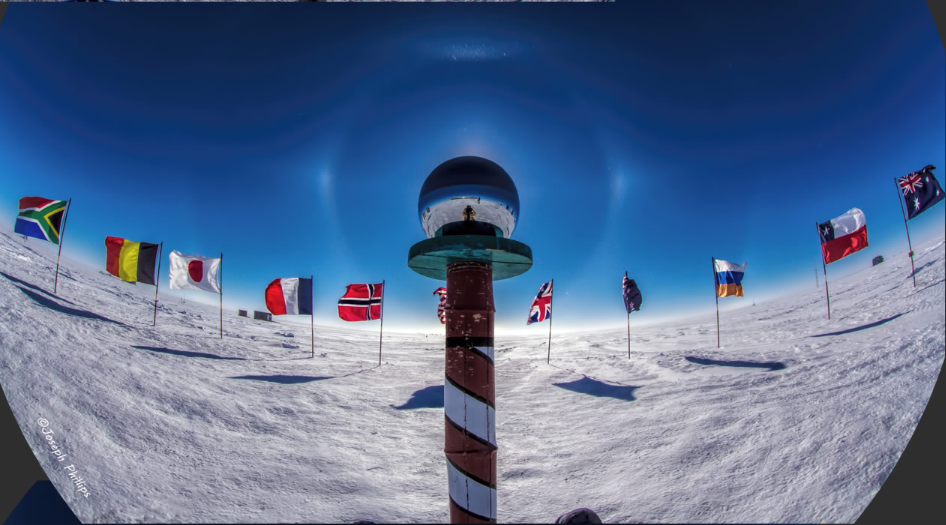
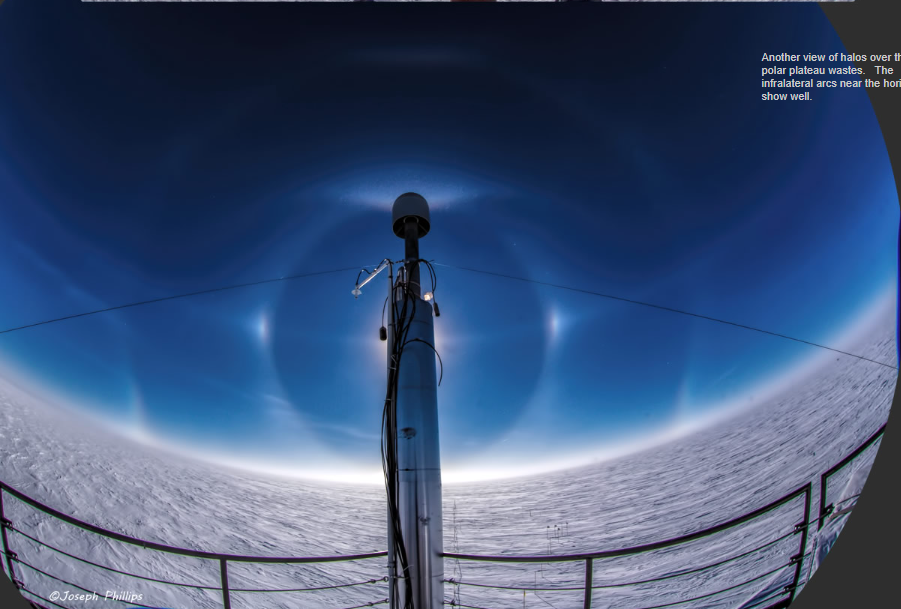
Another view of halos over the polar plateau wastes. The infralateral arcs near the horizon show well.
Note: this article has been automatically converted from the old site and may not appear as intended. You can find the original article here.
Reference Atmospheric Optics
If you use any of the definitions, information, or data presented on Atmospheric Optics, please copy the link or reference below to properly credit us as the reference source. Thank you!
-
<a href="https://atoptics.co.uk/blog/south-pole-halos-opod/">South Pole Halos - OPOD</a>
-
"South Pole Halos - OPOD". Atmospheric Optics. Accessed on April 19, 2024. https://atoptics.co.uk/blog/south-pole-halos-opod/.
-
"South Pole Halos - OPOD". Atmospheric Optics, https://atoptics.co.uk/blog/south-pole-halos-opod/. Accessed 19 April, 2024
-
South Pole Halos - OPOD. Atmospheric Optics. Retrieved from https://atoptics.co.uk/blog/south-pole-halos-opod/.